The photos at right were kindly supplied by New Zealand-based camera man Geoff Mackley who climbed to the summit craters with me on the evening of 22 June. More photos will be posted on this page as my own slides are developed.
Updates June 1998
29 June 1998
During a summit visit on 28 June, Carmelo Monaco (Istituto di Geologia e Geofisica) and a group led by him observed vigorous lava fountaining from the central vent in the Voragine. The southwestern vent in that crater was much less active and mostly ejected ash. A powerful, ash-rich explosion from Bocca Nuova was witnessed during about 30 minutes of observation; hwever, no direct views of that crater were obtained. Very mild and discontinuous explosive activity occurred at SE Crater, but slow lava effusion onto the southern flank of the SE Cone was continuous.
26 June 1998
Vigorous activity is continuing at Bocca Nuova and Voragine. On the evening of 24 June, Geoff Mackley (who climbed to the summit craters with me on the 22nd) was again at the summit and observed large explosions that ejected bombs far down the southern and southwestern flank of the summit cone, well beyond the rim of Bocca Nuova. Activity of this kind is highly dangerous because the larger explosions occur without any warning; some of the bombs are meter-sized and at times they travel and fall in clusters so that there is no means of stepping out of their trajectories even when carefully watching (this method works pretty fine with small Strombolian explosions that mainly eject scoriae and smaller bombs). In spite of this activity, tourists were observed to venture to the southern rim of Bocca Nuova that evening. This is not a prudent behavior at all and should be absolutely avoided.
That evening, SE Crater had long periods of quiet (up to 4 hours) between periods of explosive activity while effusive activity from the vent on the southern flank of the intracrater cone was continuous.
24 June 1998
The photos at right were kindly supplied by New Zealand-based camera man Geoff Mackley who climbed to the summit craters with me on the evening of 22 June. More photos will be posted on this page as my own slides are developed.
23 June 1998
Eruptive activity continues at Bocca Nuova, Voragine and SE Crater, but at slightly reduced levels compared to the activity of the previous weeks. Visits to the Bocca Nuova are still dangerous due to frequent powerful, cannon-shot-like blasts of large quantities of meter-sized bombs that may fall outside the crater. Most of such blasts observed during a visit on the afternoon-evening of 22 June were directed southwestwards; they occurred at intervals lasting from less than one minute to 10 minutes. The source vent lay in the central northern part of the partially collapsed 1997 cone at the northern eruptive area of the Bocca Nuova, it produced almost continuous minor explosions between the large detonations, ejecting large clots of fluid lava several tens of meters high. A second and smaller vent some 50 m to the south-southeast was the site of minor but vigorous sprays of large (meter-sized) bombs that occurred every few seconds from a small pool of lava at several meters depth. A narrow ribbon of flowing lava issued from a point about 30 m west of the smaller vent and extended some 100 m southwestward. Movement of this lava flow was very slow because it was emplaced on relatively flat ground where similar flows had occurred during the past three weeks.
Continuous lava fountaining occurred from a vent in the southern part of the collapsed cone in the SE part of Bocca Nuova; the highest sprays of lava remained well below the southern rim of the crater. A second vent a few meters to the E produced only infrequent and minor Strombolian bursts.
The vigorous activity observed within the Voragine one week earlier, involving Hawaiian-style fountaining and lava effusion from the central vent appears to have been a short-lived episode only; during the 22 June visit this central vent was the site of pulsating gas jets rearely charged with pyroclastics. The cone at this vent had experienced no appreciable growth during the past week and there was no evidence of recent lava emission. Vigorous lava fountaining occurred at the larger southwestern vent which had enlarged notably since last viewed from the eastern crater rim on 4 June (no comparison was possible during the 15 June visit due to a different viewpoint). During most of the time, bombs rose little higher than the rim of this vent, but occasional larger bursts ejected bombs up to 100 m high, dropping them into the adjacent Bocca Nuova. A large asymmetrical cone leaning against the thin wall between the Voragine and Bocca Nuova had grown around the vent.
At SE Crater, explosive activity occurred at various intervals from three vents at the summit of the intracrater cone, and lava issued constantly from an effusive vent located halfway up on the southern flank of the intracrater cone. The site of the effusive vent was located at the snout of the peculiar extrusive, graben-topped ridge formed in mid to late May which had suffered major extension at the resumption of effusive activity in this area on 13-14 June. Lava was moving in a well-defined flow channel towards the southern flank of the SE cone, and feeding two short lobes high up on that flank. Surges of increased lava effusion corresponded to periods of more intense explosive activity at the summit vents of the intracrater cone. During these surges, the level of lava within the flow channel rose, and new lobes of lava moved over still-hot but stagnant lobes emplaced previously on the upper slope of the SE cone.
Explosive (Strombolian) activity occurred in distinct cycles separated by periods of absolute quiet that lasted up to one hour (although lava effusion persisted even during these quiet intervals). The beginning of each cycle was marked by the appearance of a yellow-blue flame of burning gas at the vent located in the southwestern part of the summit area of the intracrater cone, accompanied by weak bomb ejections. More vigorous bursts would then follow at a larger vent adjacent to the east. Explosions would become increasingly frequent and rise progressively higher (up to 150 m above the vent), showering the southern part of SE Crater with bombs. Observations from the eastern rim of the former Central Crater revealed that at the height of such eruptive cycles, weak ejections occurred from a vent that lay in the northern part of the cone's summit area. Activity would then shift back to the southwestern vent where each Strombolian burst was accompanied by a bright yellow flame of burning gas. Even after the cessation of the bomb ejections this vent remained brightly incandescent, indicating very high gas temperatures.
It was reported that scientists of the Istituto Internazionale di Vulcanologia observed glow at NE Crater on that same evening; however, no significant eruptive phenomena were observed by us at this crater while making observations of the activity at the Voragine.
The present level of activity, although slightly lower than during the past week, continues to be elevated, with continuous eruptive activity from three craters. The magma output (eruption rate) is probably several cubic meters per second, which is similar to the mean output between flank eruptions during the period 1971-1993, and higher than what is generally assumed to be the mean output of the volcano during periods of persistent activity.
15 June 1998
SE Crater, 11 June 1998
Summit visit, 4-5 June 1998
Voragine, 15 June 1998
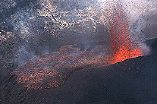
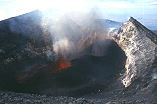
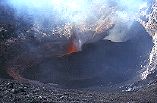
Activity at the Voragine on 15 June 1998. Vigorous lava fountaining and emission of a larger lava flow that eventually flows around the central cone to the north and south.
![]()
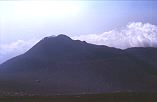
SE Crater seen from the southeastern rim of the former summit crater, showing large central conelet and lava flows overflowing southwestern rim of SE Crater to the right.
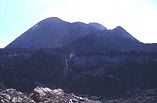
The central conelet of SE Crater viewed from the southwestern crater rim, same viewpoint as in topmost 4 June photo at right.
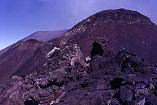
View of the central conelet of SE Crater from top of the mound formed at the effusive vents on the eastern side of the conelet. Active vent area is hidden behind the high crest at right. The lower part of the conelet to the left is the extrusive structure formed in mid-late May. Above it, the southern rim of Bocca Nuova can be seen in the background.
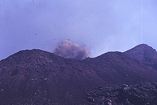
Ash-rich explosion from the southern active vent of the intracrater conelet, ejecting bombs up to 0.5 m in diameter. View is from southeastern base of the conelet.
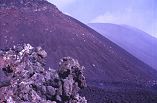
View from effusive vent area in SE Crater towards west with northern flank of intracrater conelet at left and NE Crater in the right background.
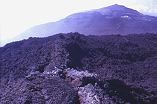
Recent lava flows ion the southeastern part of SE Crater; Montagnola is in the right background (white dot in front of Montagnola is the Rifugio Torre del Filosofo).
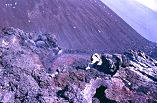
View of the active effusive vent with the northeastern flank of the central conelet in the background; the flow is moving northwards.
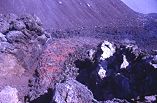
Close-up view of the effusive vent.
![]()
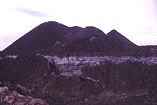
View of the central conelet from southwest rim of SE Crater. The extrusive structure mentioned in the text is visible on the right side of the cone, having the appearance of a secondary cone. Lava has issued from the front of this structure between 20 and 28 May; no significant extrusive activity has occurred since then at this site. Compare to upper right photo on the May updates page.
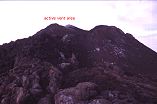
Central conelet seen from the south. Erupting vent is at the high point at left. Peak at right is the eastern part of the structure pushing outwards from conelet; extruding lava at the front of this structure is visible as a dark area at lower left flank of conelet, below the erupting vent which is marked by a steam column. Compare to second photo at right on the May updates page.
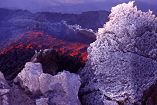
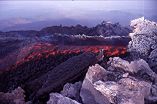
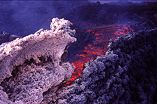
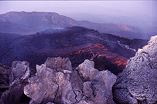
Close-up views of the effusive vent on 4 June 1998 from various points. Note the craggy slab of older lava covered with calcium sulfates at the source of the active flow.
![]()
This morning the lava flow at SE Crater had reached its southern base and was advancing very slowly; this is a flow like many others that have spilled down the flanks of that cone during the past 11 months and does not mean an increase of the activity at SE Crater. However, the most recent flow down that side occurred in late March, before the onset of the tourist season which is now in full swing.
Activity at Bocca Nuova was slightly less intense this morning than during the previous day; during a 2 h stay in the summit area from about 1000 until 1200 h local time, strong explosions occurred every 2-5 minutes, ejecting ash-rich jets of bombs that rose up to 100 m above the crater rim. Bombs fell back into the crater during activity before noon, then the explosions grew slightly stronger, and bombs fell onto the northwestern crater rim. The main source of activity was the large cone in the northern part of the Bocca Nuova whose morphology does not appear to have changed significantly since the 11 June visit. No observations of the southeastern vents were made due to the danger of falling bombs and poor visibility.
The most spectacular activity occurred at the Voragine where the major focus of activity had shifted to the central vent which was active between July and December 1997. This vent ejected continuous Hawaiian-style lava fountains while a broad lava flow spilled over the low northeastern rim of the vent to feed numerous surges of lava that rapidly extended around the base of the central cone and covered the entire eastern half of the crater floor. Fountains played up to 200 m above the vent, with all bombs falling back into the crater (allowing perfect viewing conditions from the southern rim of NE Crater). At times, the magma level in the conduit dropped, and the character of the activity changed to discrete explosions which sent large bombs higher than the preceding continuous fountains. Fountaining resumed after a few minutes, being accompanied by a new surge of lava moving over the previously emplaced, still-incandescent lava
The vent in the southwestern part of the Voragine (which produced spectacular activity in the past few weeks) showed a much more variable eruptive behavior. Periods of nosiy gas emissions containing little pyroclastic material alternated with vigorous ash emission and lava fountaining. There was a distinct increase in the vigor of bomb ejections towards the end of the observation period, but no ejecta were seen to fall outside the Voragine.
The overall impression was that of a very intense but relatively stable activity at the Voragine; the reactivation of the central vent which had shown little activity since late 1997 is a further intensification of the 1995-present summit eruption but not a distinct eruptive episode. Similar periods of heightened activity have been observed in the past three years and is no clear indicator of an impending flank eruption. Activity of this kind may continue for years, presenting a hazard only to people venturing in the summit area and structures like the Torre del Filosofo mountain hut that stands only about 1 km from SE Crater.
11 June 1998
A visit to Etna's summit craters this morning revealed very intense activity at Bocca Nuova and Voragine and ongoing mild Strombolian-effusive activity at SE Crater.
At SE Crater, there were the usual two vents in activity on the intracrater cone, the southern being the more vigorous, and numerous fresh bombs were scattered over the southern part of the SE Crater floor. Many bomb ejections were almost noiseless and frequently (mostly after a shift of the eruptive activity from the northern vent) accompanied by dense ash emissions. The northern vent produced sharp detonations and dropped bombs onto the northern side of SE Crater. The most remarkable changes since the previous visit on 4 June had occurred in the area of the effusive vents where recent flows had piled upon each other, building a high elongate (in W-E direction) mound on the eastern side of the intracrater cone. The presently active flow issued from the NW side of the effusive vent area and was directed northwards. The extent of this flow on the northern side of the SE Cone could not be checked due to falling bombs from the northern vent of the intracrater cone.
The Voragine was not visited but very strong explosive activity was well audible (detonations were heard up to more than 10 km south of the summit), and high fountains often containing meter-sized bombs were frequently seen jetting hundreds of meters above the erupting vent in the SW part of the crater during observation from the southwest rim of Bocca Nuova. Some particularly powerful explosions caused ground shaking on the summit cone and ejected wide sprays of bombs far beyond the remainder of the 1964 cone on the southern rim of the Voragine. Explosions occurred once or twice per second, the larger blasts took place every one to two minutes. There appears to be no safe observation point on the rim of the Voragine.
Direct observations of the activity within Bocca Nuova were made during about 30 minutes from the southern and southwestern crater rim. The southeastern eruptive vents showed relatively low levels of activity with fountains of ash and bombs rising only about 50 m above the lip of the main (southernmost) vent. No significant cone growth appears to have occurred since the series of collapse events earlier this year. However, at the northwestern eruptive area, three vents were vigorously active, and the deep collapse pit that had replaced the southern part of the large 1997 cone was filled with pyroclastics and recent lava flows. In contrast to the activity one week ago, today there was no lava effusion, but explosive activity was clearly more vigorous. Two closely spaced vents (the western one about 30 m in diameter while the eastern one was more than 50 m wide) were present in the central part of the filled pit, a third, much smaller vent (ca. 5 m in diameter) lay some 50-70 m to the south; this latter one almost continuously produced weak sputterings of lava blobs, building a low hornito. The two larger vents showed a repetitive eruptive behavior for the first 15 minutes of observation: after a series of nosiy gas emissions without any pyroclastic ejections, the western vent would almost noiselessly produce a dense ash plume mixed with huge incandescent bombs which fell in the immediate vicinity of the vent. This was followed within a few seconds by one or two ash-free jets from the eastern vent of low but broad fountains heavily charged with large bombs and inclined to the south; simultaneously the southern hornito produced more vigorous lava sprays.
After 15 minutes of observation, the two larger vents erupted simultaneously in a series of ash-free lava fountains over a time span of two minutes, then the eastern vent exploded violently in a blast strongly inclined to the west, causing a heavy shower of bombs far beyond the western crater rim. The impact of large bombs caused numerous rockfalls and dust clouds on the inner crater wall. For about ten minutes there were bomb ejections of varying intensity from both major vents, at times punctuated by larger explosions; at the southern vent, sputtering of lava continued.
At 1058 h local time, a powerful cannon-shot-like explosion occurred at the eastern vent, ejecting huge bombs at very low angles in all directions. Numerous meter-sized projectiles passed overhead and fell as far as the southwestern base of the summit cone, terrifying a group of tourists who were walking south on the dirt road that leads north-south on the western side of the summit cone. While descending on the southern flank of the summit cone, many fresh bombs up to 1.5 m long were encountered more than half way down the slope, and smaller bombs were found even farther downslope. No fresh bombs were found on the southeastern side of the summit cone, but centimeter-sized scoriae and abundant Pele's hair (thin threads of lava, named after the Hawaiian goddess of fire) were being continuously deposited all over that sector and on SE Crater.
I hope to post photos of today's activity on this page during the next few days.
6 June 1998
Spectacular eruptive activity was observed at three of Etna's four summit craters during a visit on 4-5 June (from the afternoon of the 4th until the early morning of the 5th). NE Crater was found completely quiet while Bocca Nuova, SE Crater and Voragine were displaying the highest level of activity seen in many months.
At SE Crater, explosive activity was varying in intensity throughout the visit, becoming more vigorous after midnight. There were at least three explosive vents on the central intracrater cone, the most active being located in the northern and southern parts of the elongate summit crater. The northern vent produced sharp hissing and crackling noises while the southern one erupted almost noiselessly. Activity alternated between both vents - as observed on previous occasions - but at times they exploded simultaneously, and it was during such common explosions that a third vent, located in the northwestern part of the summit crater, was the site of weak incandescent projections. The explosions from the northern vent ejected bombs far down the northern flank of the SE Crater cone while fallout from the southern vent occurred only up to a few tens of meters on the southern flank of the intracrater cone.
Vigorous growth of the intracrater cone during the past two weeks has occurred around the explosive vents, and the summit now stands some 20 m above the "Fortino" on the formerly highest point (about 3186 m) of the western SE Crater rim. On the northern side of SE Crater, the advancing slope of the intracrater cone has concealed the former crater rim and a talus fan of bombs and blocks is extending through what before early 1998 was a breach in the northern rim of SE Crater.
Lava issued from a vent on the eastern side of the intracrater cone and flowed towards the northeastern flank of the SE Crater cone where it spilled down to the base of the cone. The effusive vent lay somewhat to the northeast of the vent observed on 28 May, and farther away from the central cone, thus continuing a trend of effusive vents gradually shifting to greater distances from the main eruptive conduit (presumed to be the one below the central intracrater cone). The older lavas to the west of the presently active effusive vent, between this vent and the central cone, were extensively fractured, many cracks extending several meters below the elevation of the active vent, so there was no more or less horizontal feeder tube to that vent from the point where lava emission started in early April. This observation is interesting because it implies that lava is not moving horizontally outward below the base of the intracrater cone in this case, but the conduit feeding the effusive vent(s) is connected with the central conduit of the intracrater cone only at some depth.
The peculiar extrusive structure observed on the southern flank of the intracrater cone on 20 May had changed little since that date, but a modest volume of unusually viscous lava had been extruded from the front of that structure, at the southern end of the graben extending radially (away from the intracrater cone) on top of the structure. This lava formed a thick, jumbly, craggy lobe extending 20-25 m from the snout of the extrusive structure. The absence of any incandescence at this lava at night and the lack of avalanching at the extrusive structure indicated that outward movement and lava extrusion had ceased.
Eruptive activity in Bocca Nuova was occurring at both areas (in the northwest and southeast of the crater floor) that had been active previously. Continuous fluctuating incandescence was seen at night in a deep pit that had collapsed in the southern part of the southeastern eruptive area, and bombs were occasionally ejected above the lip of this pit. A few rare ejections (fortunately seen only from greater distance) rose above the southern rim of Bocca Nuova but few bombs appeared to fall outside the crater. This activity was much less noisy than that observed at the same eruptive site last year. In contrast, very noisy activity occurred at the northwestern eruptive area, at the bottom of the collapsed large cone that had grown there in 1997. At least five vents were producing spectacular explosions and lava fountains accompanied by bursts of yellowish-blue burning gas that appeared to originate from the surface of a pond of crusted-over lava that filled the collapse depression. Several lava flows extended from this pond over the floor of Bocca Nuova to the west and southwest; in spite of their brilliant incandescence little significant movement was observed during 15 minutes of observation. The strongest explosions from this area launched bombe high above the crater rim, and at times incandescent ejecta fell outside the crater to the west and north. The explosions consisted of pulsating fountains, often jetting simultaneously from several vents, and the surrounding surface of the lava pond showed a strong pulsating agitation.
The most impressive activity took place in the Voragine, at the vent that had been first observed on 6 November in the southwestern part of the crater floor. This vent had enlarged notably since last seen on 6 April and shifted somewhat away from its original location at the base of the "diaframma", the thin wall between the Voragine and Bocca Nuova. A low pyroclastic cone had grown around the vent, partly burying the conelet that had formed in the center of the crater floor between July and December 1997 and which had only a meter-sized, brightly incandescent degassing hole in its center. An increase of the activity at the southwestern vent had been observed in the past month, but during the previous days, the activity had grown considerably. On 3 June, near-continuous cannon-shot like detonations were heard kilometers away, and Marco Fulle (Osservatorio Astronomico, Trieste) ovserved huge magma bubbles burst within the vent at the onset of periods of continuous fire-fountaining. The southwestern and western rims of the crater were heavily showered with large bombs making any approach from that side (which is the one commonly used by visitors climbing from the parking lot located at the northwestern base of Etna's summit cone) highly dangerous. The crater rim was thus reached from the eastern side, climbing up from SE Crater; in this area few fresh bombs but abundant light scoriae were found.
On the evening of 4 June, activity at the Voragine was observed continuously for about 4 hours from a point on the eastern rim. For the first 10-15 minutes of observation, lava was splashing within the vent, and a dense gas column rose hundreds of meters above the crater. Then the ejections became stronger, often rising above the crater rim, and about 20 minutes after the beginning of observation a sustained fountain jetted from the vent, accompanied by a deafening roaring noise and strong tremors felt on the crater rim. The southwestern part of the crater floor and the crater rim on that side were incessantly showered with bombs which cascaded down the inner crater walls and covered most of the crater floor, including the July-December 1997 central conelet. Many bombs were ejected over the "diaframma" and fell abundantly into the Bocca Nuova.
This fountain lasted about 75 minutes; it was followed by a rapid drop of the top of the magma column in the vent and a temporary state of exhaustion. During this brief interval, there was a continuous spectacular sliding of pyroclastic material from the inner walls of the active vent into its throat, exposing the incandescent interior below. After a few minutes, a small vent suddenly blasted open immediately below the inner southeastern rim of the vent and began to send jets of incandescent lava at a very low angle (about 15� from the horizontal) towards NE, in the direction of NE Crater. Ejections soon resumed at the main vent, and a flame of burning yellowish-blue gas persisted at the subsidiary vent for some time, accompanied by weak sprays of incandescent pyroclastics.
A new period of fountaining began at the main vent; this time the fountain was pulsating and inclined (about 25� from the vertical) to the south-southeast, resulting in the continuous fall of bombs onto the "diaframma" and into Bocca Nuova. During this period, the pyroclastic cone around the vent grew notably by the rapid accumulation of bombs and spatter. The subsidiary vent that had opened during the temporary lull in activity at the main vent was soon buried. At times, large portions of the inner conduit walls collapsed into the vent, exposing brightly incandescent surfaces, deflecting the fountain in various directions, and causing the formation of ash-rich fountains as the vent cleared its throat from the collapsed material.
This activity continued to the end of the observation period and thereafter with many very high lava jets (at least 150 m above the summit of the 1964 cone remainder which stands at the southern junction of the Voragine and Bocca Nuova crater rims). The level of noise from this activity was variable; between 0100 and 0200 h loud roaring was heard continuously at Torre del Filosofo, accompanied by the sharp crackling noise from SE Crater and occasional loud detonations from Bocca Nuova.
The activity in general is the strongest seen at Etna's summit craters in many months, both in terms of duration and the number of vents involved (some episodes of lava fountaining from NE Crater in late 1995, early 1996 and on 27-28 March 1998 were more intense but lasted only a few hours; the current heightened activity is lasting since about one week). The current activity at the Voragine is the strongest seen in this crater since it became active in July 1997, and among the most vigorous eruptive phenomena of the entire period of summit activity initiated almost three years ago. While the activity in Bocca Nuova is far below the levels of August-December 1997, it may herald a new phase of crater filling similar to that of last year; the fact that lava is extruding onto the crater floor indicates that the top of the magma column is rising again after many months of only degassing activity that probably was related to subsidence of the magma column. SE Crater activity, in contrast to the fluctuating activity at Voragine and Bocca Nuova, has proved to be relatively regular throughout the past twelve months.
The current combined mass eruption rate of all three craters in eruption is estimated to be in the range of 3-5 cubic meters per second, higher than the calculated long-term output of Etna in periods of persistent summit activity (which is generally supposed to be around 1 cubic meter per second). This does not, though, imply any significant change in the present eruptive regime at Etna, such as the uprise of a voluminous batch of fresh, gas-rich magma which in turn could lead to a new flank eruption. Yet the volcano is vigorously active, and it has to be noted that between 1971 and 1993, similar activity was usually a predecessor of flank eruptions while after the most recent (1991-1993) flank eruption, the volcano appears to be considerably more stable.
1 June 1998
There appears to have been a slight increase in the activity of Etna's summit craters over the weekend. Bocca Nuova has resumed activity after several months of little activity, and this morning there was a series of ash emissions from NE Crater which had been quiet since its major eruptive episode on 27 March. Activity at SE Crater and Voragine continues like before. There is no change to the seismic activity and the intensification is a normal process in the current summit activity.